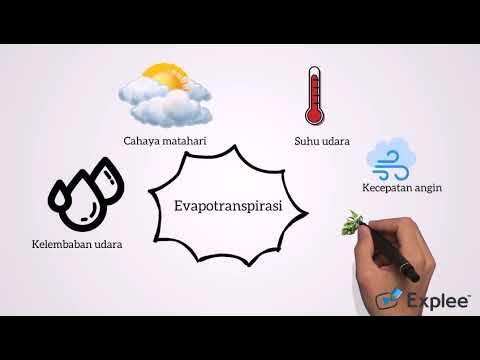Hidrologia 1 Evapotranspiração 6 Medição de evapotranspiração
Summary
TLDRThis video explains different methods for measuring evapotranspiration (ET), which includes the combination of evaporation and transpiration from plants. It covers methods like using a standardized evaporation tank, the lysimeter for agricultural crops, and the advanced vortex covariance method for natural vegetation. The video also touches on the water balance method for large-scale river basins. While the vortex covariance method provides detailed real-time data, it remains mainly for research due to its cost. The lysimeter method is more common in agriculture, estimating potential evapotranspiration under adequate water conditions. Each method offers distinct benefits depending on the scale and focus of the study.
Takeaways
- 😀 Evapotranspiration is a complex process combining evaporation, transpiration, and direct soil evaporation, making it harder to measure compared to simple evaporation.
- 😀 The lysimeter method is a common way to measure evapotranspiration by measuring the change in weight of a tank containing soil and vegetation, which accounts for precipitation and drainage.
- 😀 The lysimeter method is particularly useful for agricultural studies, estimating potential evapotranspiration when water availability is consistent.
- 😀 The vortex covariance method is a modern technique used to measure evapotranspiration in natural vegetation by analyzing vertical wind speed and air humidity.
- 😀 Vortex covariance method provides real-time data on evapotranspiration and latent heat flux, but it is more expensive and typically used for scientific research.
- 😀 The method of vortex covariance is based on the concept of atmospheric vortices created by varying wind velocities near the surface, which help transport heat and water vapor.
- 😀 The vortex covariance method requires measuring both the vertical wind speed and air humidity, providing detailed measurements of water vapor transfer between vegetation and the atmosphere.
- 😀 Evapotranspiration measurements from vortex covariance are typically performed on large vegetation areas, such as forests or agricultural fields, where small patches of vegetation are not representative.
- 😀 The water balance method uses long-term data from river basins to estimate evapotranspiration by calculating rainfall and flow, but it cannot provide short-term or precise measurements.
- 😀 Although expensive, the vortex covariance method is a valuable tool for monitoring evapotranspiration in large-scale ecosystems like the Amazon rainforest or sugarcane fields.
- 😀 Understanding evapotranspiration is crucial for water management, crop irrigation, and ecosystem studies, helping us gauge the availability of water and plant health across various scales.
Q & A
What is the primary difference between measuring evaporation and measuring evapotranspiration?
-Evaporation is easier to measure and typically done using standardized tanks to track the decrease in water levels. In contrast, evapotranspiration is more complex as it combines plant transpiration, evaporation of intercepted water, and direct evaporation from the soil, requiring more specialized methods.
How does a lysimeter help in measuring evapotranspiration?
-A lysimeter is used to measure evapotranspiration by weighing a tank that contains soil and vegetation. The water balance in the tank, which includes precipitation and drainage, helps estimate evapotranspiration by tracking changes in weight from one day to the next.
What role do the drains in a lysimeter play?
-The drains in a lysimeter measure runoff, both underground drainage and surface runoff, which are necessary for accurately calculating the water balance and, ultimately, evapotranspiration.
What is potential evapotranspiration, and how does a lysimeter measure it?
-Potential evapotranspiration refers to the evapotranspiration that occurs under conditions of unlimited water availability. A lysimeter can measure this by ensuring adequate water supply, including supplemental irrigation when needed.
Why is measuring evapotranspiration from large vegetation using a lysimeter difficult?
-Measuring evapotranspiration from large vegetation using a lysimeter is impractical because it would require waiting many years for the vegetation to grow large enough, making it unfeasible for large trees or mature vegetation.
What alternative method is used for measuring evapotranspiration in large vegetation or natural environments?
-The vortex covariance method is commonly used to measure evapotranspiration in large vegetation or natural environments. This technique directly measures the transfer of water vapor between the surface and the atmosphere using high-frequency measurements of wind speed and air humidity.
How does the vortex covariance method work?
-The vortex covariance method works by measuring vertical wind speed and humidity of the air. It calculates the product of the vertical velocity and humidity oscillations, which helps estimate the latent heat flux and, consequently, evapotranspiration.
What are the key components involved in the vortex covariance method's measurement setup?
-The key components of the vortex covariance method include an anemometer to measure vertical wind speed, a humidity sensor to measure air humidity, and the calculation of the product between vertical wind speed and air humidity fluctuations.
What is the significance of measuring evapotranspiration using the vortex covariance method over a day or year?
-Measuring evapotranspiration over a day or year using the vortex covariance method provides detailed, high-frequency data that accounts for variations in radiation, humidity, and wind patterns, making it possible to track the impact of environmental changes on evapotranspiration.
What other method is used to estimate evapotranspiration in large regions like river basins?
-In large regions, evapotranspiration can be estimated using the water balance method of river basins. This involves measuring rainfall, evaporation, and flow at multiple points in the basin to calculate evapotranspiration over an extended period.
Outlines

此内容仅限付费用户访问。 请升级后访问。
立即升级Mindmap

此内容仅限付费用户访问。 请升级后访问。
立即升级Keywords

此内容仅限付费用户访问。 请升级后访问。
立即升级Highlights

此内容仅限付费用户访问。 请升级后访问。
立即升级Transcripts

此内容仅限付费用户访问。 请升级后访问。
立即升级5.0 / 5 (0 votes)






